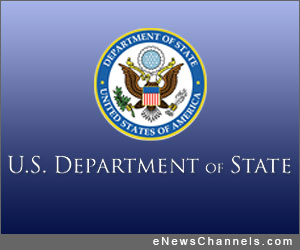 WASHINGTON, D.C. /eNewsChannels/ — Today, the U.S. Department of State released a Draft Supplemental Environmental Impact Statement (SEIS) in response to TransCanada’s May 2012 application for the Keystone XL pipeline that would run from Canada to Nebraska. The document is a draft technical review of potential environmental impacts associated with the proposed Project, including: impacts from construction, impacts from potential spills, impacts related to climate change, and economic impacts. The Draft SEIS is available at: http://keystonepipeline-xl.state.gov/draftseis/index.htm.
WASHINGTON, D.C. /eNewsChannels/ — Today, the U.S. Department of State released a Draft Supplemental Environmental Impact Statement (SEIS) in response to TransCanada’s May 2012 application for the Keystone XL pipeline that would run from Canada to Nebraska. The document is a draft technical review of potential environmental impacts associated with the proposed Project, including: impacts from construction, impacts from potential spills, impacts related to climate change, and economic impacts. The Draft SEIS is available at: http://keystonepipeline-xl.state.gov/draftseis/index.htm.
A 45-day public comment period will begin when EPA posts the Draft SEIS on its website, a process that generally takes about one week following today’s submission of the document to that agency. Specific instructions about how to submit comments will be provided via the Federal Register and on the State Department Keystone XL website.
After the end of the public comment period, the Department will consider comments received and prepare a Final SEIS. The National Interest Determination period will begin following the release of the Final SEIS, during which time the Department will obtain the views of other agencies about whether to grant or deny the permit.
TransCanada submitted a new application for the Keystone XL Project on May 4, 2012. On March 1, 2013 the U.S. Department of State (the Department) released a Draft Supplemental Environmental Impact Statement (Draft SEIS) for the proposed project that is consistent with the National Environmental Policy Act (NEPA).
The proposed Keystone XL project consists of a 875-mile long pipeline and related facilities to transport up to 830,000 barrels per day (bpd) of crude oil from Alberta, Canada and the Bakken Shale Formation in Montana. The pipeline would cross the U.S. border near Morgan, Montana and continue through Montana, South Dakota, and Nebraska where it would connect to existing pipeline facilities near Steele City, Nebraska for onward delivery to Cushing, Oklahoma and the Texas Gulf Coast region.
The 2008 Application
As part of its review of the 2008 application, the Department determined in November 2011 that environmental concerns, including those raised by the State of Nebraska, required additional information to ensure complete and transparent evaluation of alternative routes, specifically within Nebraska, that would avoid the Sand Hills. Congress subsequently included a provision in the Temporary Payroll Tax Cut Continuation Act that sought to require a decision on the Permit within 60 days. That deadline did not allow sufficient time to prepare a thorough, rigorous and transparent review of an alternative route through Nebraska. As such, the Presidential Permit was denied.
The 2012 Application
The Department is currently reviewing an application submitted by TransCanada in May 2012. This Draft SEIS presents an impact assessment that, where appropriate, draws upon the analysis released in August 2011 for the 2008 application. The Draft SEIS analyzes the newly proposed route, and presents expanded and updated information, especially with regard to the revised proposed route through Nebraska, as well as significant new circumstances or information that is now available for the entire route.
Following the receipt and publication of the May 2012 application, the Department asked for public comment on the scope of the Draft SEIS. These comments, as well as comments from other government agencies, were taken into consideration within the Draft SEIS.
Nebraska Review
The Department and the Nebraska DEQ signed a Memorandum of Understanding in May 2012 to ensure coordination of the State and Federal review efforts. The State of Nebraska released its review of the proposed route, based on their law, in December 2012. The Governor of Nebraska approved the new route through Nebraska in January 2013. The Department runs a complementary process on the entire route that is broader in scope and consistent with NEPA.
Once the Draft SEIS is noticed in the Federal Register, a 45-day public comment period will begin. A public meeting will be held during the comment period in Nebraska at a date and location to be determined. As part of the Department’s process, members of the public, public agencies, and other interested parties are encouraged to submit comments, questions, and concerns about the project via e-mail to:
keystonecomments@state.gov, at http://www.keystonepipeline-xl.state.gov/
or mailed to:
U.S. Department of State
Attn: Genevieve Walker, NEPA Coordinator
2201 C Street NW, Room 2726
Washington, D.C. 20520
After the comment period, appropriate revision of the draft, and subsequent publication of the Final SEIS, the Department will lead an inter-agency inquiry into whether the proposed Project serves the national interest. The national interest determination by the Department involves consideration of many factors, including energy security; environmental, cultural, and economic impacts; foreign policy; and compliance with relevant federal regulations and issues. During this time the Department will consult with, at least, the eight agencies identified in Executive Order 13337 (April 30, 2004). The eight agencies identified in the Executive Order are the Departments of Defense, Justice, Interior, Commerce, Transportation, Energy, Homeland Security and the Environmental Protection Agency.
For updates and further information please visit: http://www.keystonepipeline-xl.state.gov/



